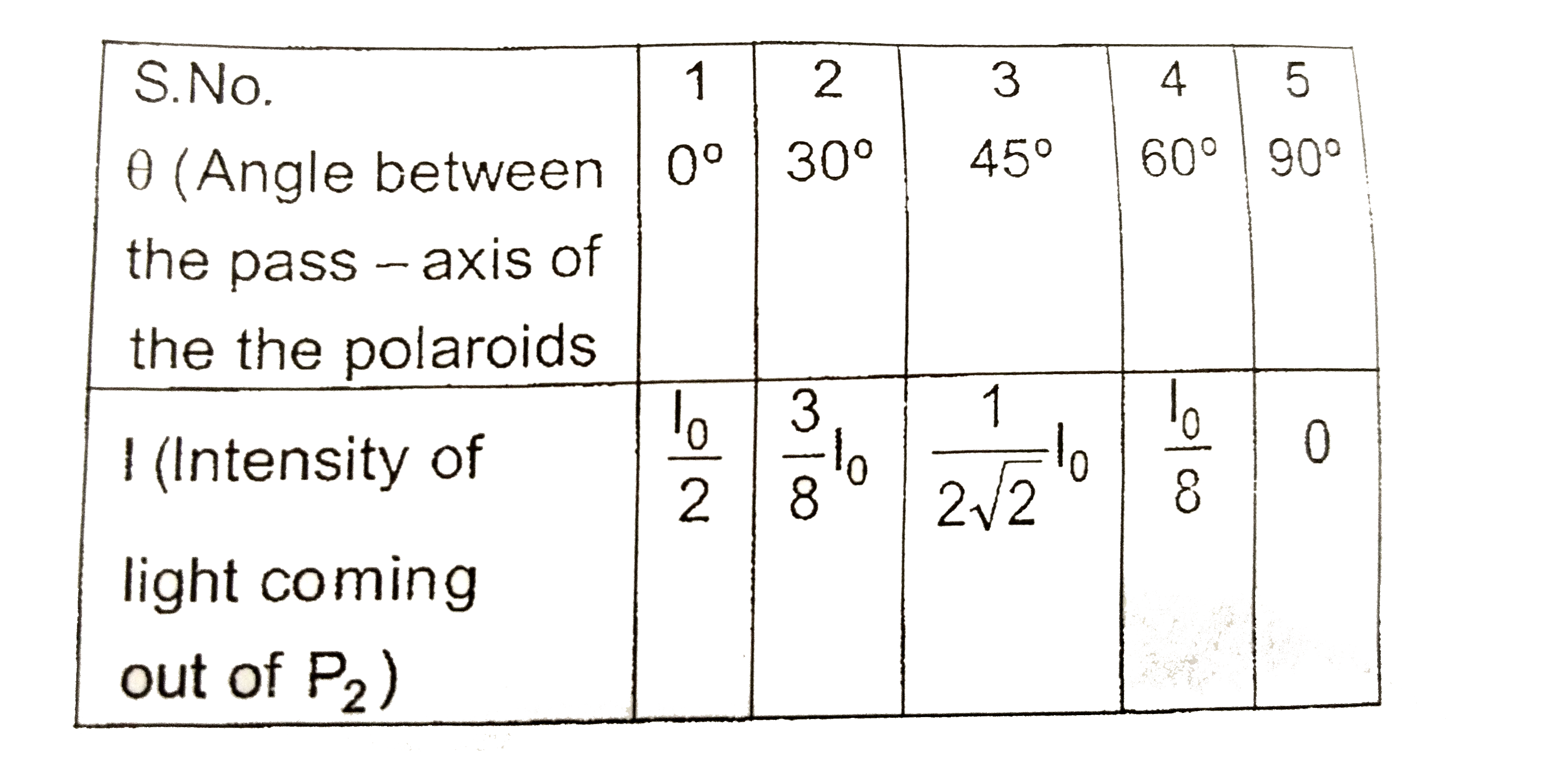Light from sodium lamp is made to pass through two polaroids placed one after the other in the path of light. Taking the intensity of the incident light as 100%, the intensity of the out coming light that can be varied in the range
0% to 100%
0% to 50%
0% to 25%
0% to 75%
The correct Answer is:B
To solve the problem, we need to determine the intensity of light that emerges after passing through two polaroids, given that the intensity of the incident light is 100%. We will use Malus's Law, which states that when polarized light passes through a polarizer, the intensity of the transmitted light is given by:
I=I0cos2(θ)
where:
- I is the transmitted intensity,
- I0 is the incident intensity,
- θ is the angle between the light's polarization direction and the axis of the polarizer.
1. Identify the Incident Intensity:
- The intensity of the incident light from the sodium lamp is given as I0=100%.
2. First Polaroid:
- When the light passes through the first polaroid, the intensity is reduced to half. According to the properties of polaroids, we have:
I1=I02=100%2=50%
3. Second Polaroid:
- Let θ be the angle between the transmission axes of the two polaroids. The intensity after the second polaroid can be calculated using Malus's Law:
I2=I1cos2(θ)
- Substituting I1:
I2=(I02)cos2(θ)=(100%2)cos2(θ)=50%cos2(θ)
4. Determine the Range of I2:
- The angle θ can vary from 0∘ to 90∘.
- At θ=0∘:
I2=50%cos2(0)=50%⋅1=50%
- At θ=90∘:
I2=50%cos2(90)=50%⋅0=0%
- Therefore, as θ varies from 0∘ to 90∘, I2 varies from 50% to 0%.
5. Conclusion:
- The intensity of the outgoing light can vary in the range from 0% to 50%.
Final Answer:
The intensity of the outgoing light can be varied in the range of 0% to 50%.
- I is the transmitted intensity,
- I0 is the incident intensity,
- θ is the angle between the light's polarization direction and the axis of the polarizer.
- The intensity of the incident light from the sodium lamp is given as I0=100%.
- When the light passes through the first polaroid, the intensity is reduced to half. According to the properties of polaroids, we have:
I1=I02=100%2=50%
- Let θ be the angle between the transmission axes of the two polaroids. The intensity after the second polaroid can be calculated using Malus's Law:
I2=I1cos2(θ)
- Substituting I1:
I2=(I02)cos2(θ)=(100%2)cos2(θ)=50%cos2(θ)
- The angle θ can vary from 0∘ to 90∘.
- At θ=0∘:
I2=50%cos2(0)=50%⋅1=50%
- At θ=90∘:
I2=50%cos2(90)=50%⋅0=0%
- Therefore, as θ varies from 0∘ to 90∘, I2 varies from 50% to 0%.
- The intensity of the outgoing light can vary in the range from 0% to 50%.
The intensity of the outgoing light can be varied in the range of 0% to 50%.
Topper's Solved these Questions
- BOOK - NCERT FINGERTPS ENGLISHCHAPTER - WAVE OPTICSEXERCISE - HIGHER ORDER THINKING SKILLS8videos
WAVE OPTICS
- BOOK - NCERT FINGERTPS ENGLISHCHAPTER - WAVE OPTICSEXERCISE - NCERT EXEMPLAR PROBLEMS5videos
WAVE OPTICS
- BOOK - NCERT FINGERTPS ENGLISHCHAPTER - SEMICONDUCTOR ELECTRONICS : MATERIALS , DEVICES AND SIMPLE CIRCUITS EXERCISE - Assertion And Reason15videos
SEMICONDUCTOR ELECTRONICS : MATERIALS , DEVICES AND SIMPLE CIRCUITS
Similar Questions
Unpolarised light passes through two polaroids, the axis of one is vertical and that of the other is at 45∘ to the vertical. Then, the intensity of the transmitted light is
View SolutionUnpolarized light passes through two polaroids, the axis of one is vertical and that of the other is 30∘ to the vertical . What is the orientation and intensity of the transmitted light ?
View SolutionAt what angle should the axes of two polaroids be placed so as to reduce the intensity of incident unpolarized light to 1/3.
View SolutionAn unpolarized light is successively throgh two polaroids, each with their transmission axis parallel. If the intensity of unpolarized light be l0, then intesity of the light after emerging from second polarizer will be
View SolutionWhat is meant by a linearly polarised light? Which type of waves can be polarised? Briefly explain a method for producing polarised light. Two polaroids are placed at 90∘ to each other and the intensity of transmitted light is zero. What will be the intensity of transmitted light when one more polaroid is placed between these two bisecting the angle between them ? Take intensity of unpolarised light as I0
View SolutionThe polariser and analyser are inclined to each other at 60∘. If I/2 is the intensity of the polarised light emergent from analyser. Then the intensity of the unpolarised light incident on the polariser is
View SolutionWhen a plane polarised light is passed through an analyser and analyser is rotated through 90∘, the intensity of the emerging light
View SolutionIf there is zero absorption in the polaroid and if the intensity of plant-polarized light coming out of polaroid is A2 , then the intensity of the incident beam will be
View SolutionThe polariser and analyser are inclined to each other at 60∘. The intensity of polarised light emerging from polariser is I. The intensity of the unpolarised light incident on the polariser is
View Solution(a) Light, from a sodium lamp, is passed through two polaroid sheets P1 and P2 kept one after the other. Keeping P1 fixed, P2 is rotated so the its 'pass-axis' can be at different angles, θ, with respect to the pass-axis of P1
An experimentalist records the following data for the intensity of light coming out P2 as a function of the angle θ.

[I0= Intensity of beam falling on P1]
One of these observation is not is agreement with expected theoretical variation of l. ldentify this observation and write the correct expression.
(b) Define Brewster angle and write the expression for it in terms of the refractive index of the medium.View Solution

